Tree Care: Mulch Madness – How to Properly Mulch a Tree!
What is mulch?
The most common type of mulch is recycled wood waste in the form of wood chips. However, there are many varieties of mulch, both organic and inorganic. Blue Water Baltimore recommends sticking with natural, organic mulch derived from plants such as hardwood and softwood bark, leaves, and cocoa hulls. Mulch decomposes at different rates depending on the specific material, climate and microorganisms present.
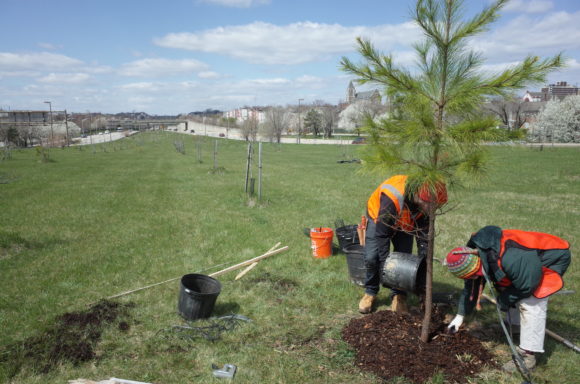
Photo: Blue Water Baltimore staff and volunteers caring for young trees at one of our largest planting sites, US Route 40
Why mulch?
Mulching mimics some of the benefits usually enjoyed by trees in a forest setting where leaves and other organic materials break down into soil. While not as rich in nutrients, mulch can help improve soil conditions as it decomposes.
The main benefit of mulch is that it acts like a sponge and holds moisture. This is HUGE during hot summer months in the city when trees are stressed by drought. Mulch is especially valuable for newly planted trees that do not yet have extensive root systems. For some shallow-rooted species, such as river birch, mulching protects against root sunburn. Mulch is also popular because it provides landscaped areas with a uniform, tidy look.
Mulch suppresses grass and weeds, which will compete with young trees for much-needed water and nutrients. Mulch rings can also reduce trunk damage caused by lawn mowers and weed wackers. If grass grows close to the tree trunk, lawn & maintenance crews inadvertently get too close with their power tools and create wounds in the bark at the base of the tree. Weed wacker damage is one of the main causes of young tree mortality!
*A note on tree biology:
Plants never heal from wounds. They simply block off the damaged area through a process called compartmentalization. Damage to the bark, specifically the cambium (the paper-thin layer just under the bark) halts the transportation of nutrients and water between leaves and roots. Not good! If this occurs around the entire circumference of the trunk (called girdling) the tree will die.Therefore, in addition to mulch, young trees should also always be protected by plastic mower guards for their first several years in the ground.
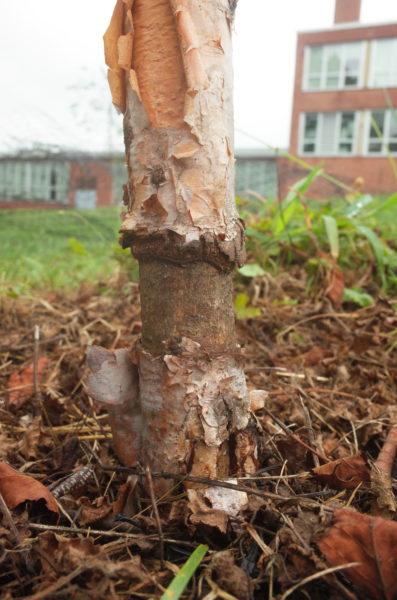
Photo: A young river birch that was girdled by intense weed wacker damage around its trunk.
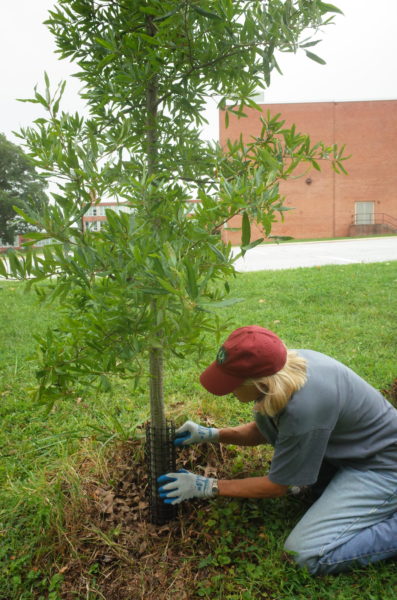
Photo: One of our dedicated volunteers, Nancy, places a plastic mower guard around the base of a young willow oak.
A note on inorganic and dyed mulches:
Inorganic mulches, such as pulverized rubber, gravel, or landscape fabric, cause environmental problems and are not recommended for use. These materials do not decompose or improve soil structure. They wash away in rain storms and become litter in our waterways. Dyed mulches (red, black, green etc.) leach toxic chemicals that harm beneficial soil bacteria, insects and even your plants. Not only are the dyes harmful, but the wood sources are questionable. The types of wood that can absorb these dyes often come from pallets or reclaimed treated wood from construction or demolition sites. Dyed mulch contains chemicals such as creosote and CCA (Chromated Copper Arsenate, used in the manufacturing of pressure-treated wood). Not something you want to put in your garden!
Incorrect Mulching Practices
Unfortunately, improper mulching is a common sight in many landscaped areas. The dreaded mulch volcano is created when mulch is piled in a tall mound up against the tree trunk.
How do you determine if a tree is improperly mulched? First, find the root flare. The root flare is the area at the base of the tree where the trunk flares out, or grows wider. This flare can be more apparent on some trees than others. If you are having trouble finding it, look instead for the topmost root extending off the trunk.
If your tree looks more like a telephone pole – without any taper along the trunk – then it is most likely buried too deep in mulch. (Note: Improper mulching can also occur as a result of improper tree planting. When measuring the depth of your planting hole, always make sure the root flare is level with, or slightly above ground level!)
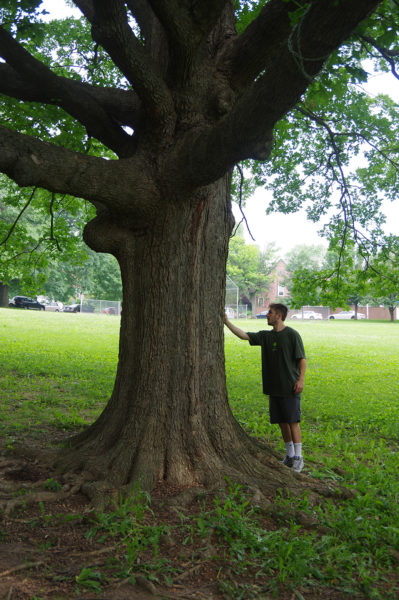
Photo: Visible root flare on a mature oak tree in Wyman Park
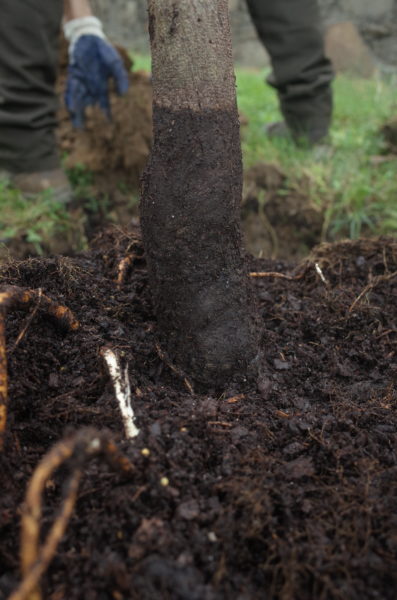
Photo: An Eastern redbud that arrived from the nursery with its root flare buried by 3 inches of soil.
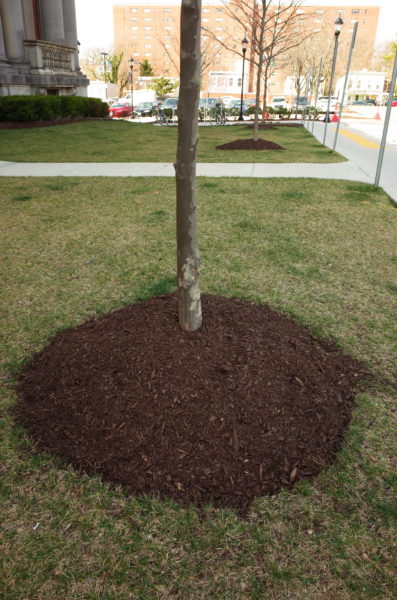
Photo: Where is my root flare? An American sycamore trunk buried with more than 7 inches of mulch volcano.
If mulch is piled against the tree trunk and covering the root flare for a prolonged period, it will greatly reduce the tree’s lifespan. First, microbes in the damp mulch cause the bark to rot, which can lead to insect damage and disease. It will also restrict important gas exchange of carbon dioxide and oxygen between the living bark (phloem) and the air. Mulch volcanoes are like wearing wet socks indefinitely!
Excessively piled mulch causes tree roots to begin to grow above the ground level rather than in the soil underneath. Over time, these roots will run out of space and begin to circle around the trunk. They can eventually girdle or choke the tree. Mulch volcanoes can also lead to desiccation, or extreme dryness, of the roots.
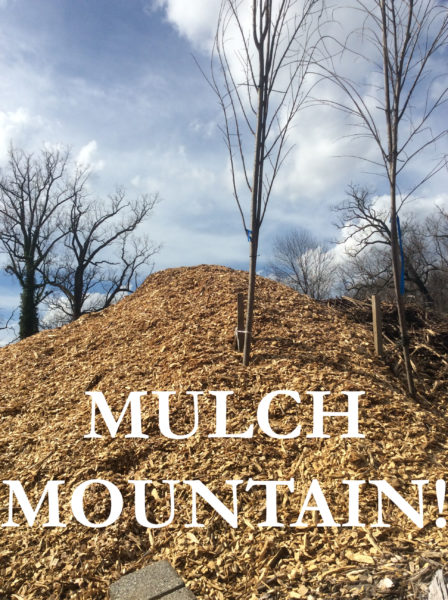
Photo: Mulch mountains, while rare, are also to be avoided! A truly impressive and horrifying sight!
How do you properly apply mulch?
Do you like donuts? Not as much as trees do! Make a large ring, or mulch donut, 2-4 inches deep around the trunk of the tree. Keep the area in the center around the trunk clear, so that you can see the root flare and soil beneath. Proper seasonal mulching twice a year in the spring and fall is recommended for most landscaped trees and shrubs.
Contrary to popular belief, tree roots are not a mirror image of the canopy above. Roots can extend far beyond the reaches of branches and they do not go nearly as deep. A thin layer of mulch, applied as widely as possible, can improve soil structure, oxygen levels, temperature and moisture availability where these roots grow. Most mulch rings reach 2-3 feet out from the trunk. If asked, the tree would tell us they prefer mulch to extend all the to the drip line (edge of the canopy spread) and beyond! Again, this mimics a forest setting where leaves and other organic materials are always cyclically growing, dying and decomposing. (A side note: Consider leaving your leaves alone! Not raking in the areas under trees can really improve soil content. Plus, you will have less grass to mow! Did you know, in one hour of operation, a gas powered lawn mower produces the same amount of volatile organic compounds and nitrogen oxides emissions as eleven cars?)
Finally, don’t mulch too deep. A thick mat of mulch may become impenetrable and block water from thirsty roots at ground level.

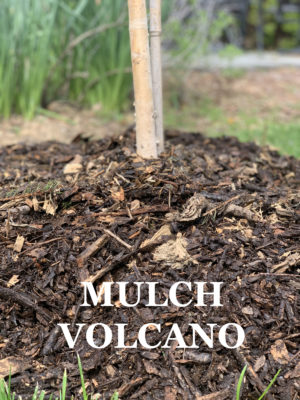
Where to buy mulch?
We sell mulch at our very own Herring Run Nursery!
Also, Baltimore City’s Department of Recreation & Parks, as part the TreeBaltimore Partnership, runs Camp Small, a wood re-utilization facility. Camp Small sometimes hosts free mulch giveaways for Baltimore City residents. Keep an eye on their social media page for upcoming events! IG: @campsmall.baltimorecity @treebaltimore
Happy mulch madness from your local forestry team at Blue Water Baltimore!
Zoe G is Blue Water Baltimore’s Community Engagement Manager. In this role, she leads community tree plantings and maintenance with our lovely volunteers. She also organizes our free tree giveaway program and assists with ecoliteracy and educational activities.


